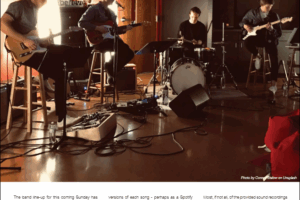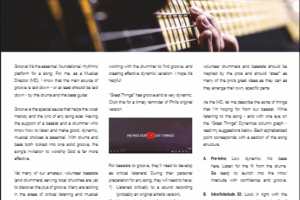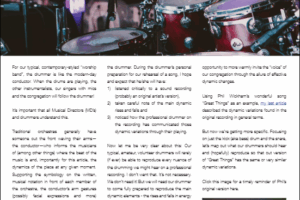Take this link to read Grant’s article as featured in the October issue of Worship…

DEEP PURPLE & THE CASE AGAINST IN-EAR MONITORS
By Grant Norsworthy
One of my favorite moments in rock history can be heard on Deep Purple’s “Made in Japan” double live album from 1972. At that time Deep Purple were recognized by The Guinness Book of World Records as the world’s “loudest band”. If you’re a music and sound enthusiast, this is essential listening and wonderfully exposes an ugly phase in the history of live band sound. In particular, the open speaker “monitor wars”.
It’s a very brief discussion between lead vocalist Ian Gillan and (I presume) the band’s beside-stage monitor engineer. You can hear it just after their blisteringly-loud rendition of “Smoke on The Water”. If you haven’t heard it, you should. Take this YouTube link and listen from 7m20s for about 15 seconds.
Gillan says that he wants, “Everything louder than everything else!”
Makes me laugh! Surely, no statement better represents the bad old days of loud stage sound and the struggle – even the impossibility – of giving band members, especially vocalists, the monitor sound they want through open speakers.
Some years later, the “Everything louder than everything else!” headaches of the “monitor wars” crept into churches too. Some are still at war. A solution had to be found. Along with other technological “breakthroughs” like drum enclosures, and amp-modeling pedals (I’m not a fan of either) in-ear monitors (from hereon called IEMs) seemed to declare an end to the “monitor wars”.
As the technology has become more affordable and simpler to operate, just about every Christian Church music team in the western world either has in-ear monitors or wants them. Conventional audio-tech wisdom would say that switching from the older technology of open speaker monitors to IEMs is the best thing to do. But are IEMs really a good move?
Sure, we enjoy lower stage volume and greater control over Front of House (FOH) and monitor mixes with IEMs. But have we fully counted the cost – in more than just dollars – of using IEMs? I don’t think we have.
No one wants a return to the “Everything louder than everything else!” conflict of open speaker wedges, side fills and stage volume that overruns the FOH. But maybe the problem is not with the choice of hardware, but is, instead, in our loss of focus on an agreed goal and an unwillingness to make selfless choices to achieve that goal.
The en masse move to IEMs – now even for smaller church halls and congregations of 200 or less – makes me wonder if we have lost sight of the main purpose of Church music.
Surely the main purpose of music in a Church gathering is connection. Vertical and horizontal connection. Through songs, we want everyone – congregation and band – to connect with God and each other. With one voice, we want to pour out praises and prayers to The Almighty, encourage others in our congregation to do the same and remind each other of the Truths of The Gospel.
Our main purpose is to dissolve the barrier – blur the line – between platform and congregation so we all know one, common purpose: Our Church community sings together as an expression of worship to God.
Do IEMs help or hinder connection? Togetherness? I am going to argue that, in most Church music situations, IEMs hinder.
Consider this: The main purpose of IEMs is to isolate, not to connect. To give the singer or instrumentalist a monitor sound that is separate, cut off, individualized and distinct from the sound of others in the ensemble and the sound that the congregation is hearing.
From the audio technician’s perspective, IEMs help isolate the room sound from the stage sound. IEMs give the FOH audio engineer greater control, but does so by isolating the elements from one another.
But we’re aiming for connection, not isolation!
This isolation goes beyond just the technicalities of sound. Singers and instrumentalists using IEMs can easily feel musically and even personally isolated too! Comments from IEM users often include statements like:
“I find them helpful but don’t enjoy them.”
“I don’t like ‘em, but I guess they’re a necessary evil.”
“For singing with loud bands I understand why you would use them.”
“I hate them because my voice feels isolated and the music never blends together like it does in a room.”
“I find it so hard to be connected with the band, the song and the crowd.”
“They’re a vibe killer.”
To my mind, the “vibe” that is being killed – or at least badly wounded – with IEMs is connection. Our main objective is being sacrificed in favor of lesser objectives like sonic clarity, the desire for more control and the monitor requirements of individuals.
Yes, we want good, clear sound and we want to provide monitors that inspire, but these goals should not be more important than achieving horizontal and vertical connection. I have found that a team of individuals on the platform who are each feeling isolated will very likely leave the congregation feeling isolated as well.
Why do so many IEM users pop one ear out? Or even both? Despite often-parroted warnings from audiologists, we want to connect. We want to feel the vibe! We want to know we’re part of something that’s bigger than just one person. And we’re prepared to sacrifice some sonic clarity, performance confidence and possible hearing damage to achieve it.
We recognize – perhaps unconsciously – that IEMs are working against the all-important, main objective of connection.
Bottom line: If I desire to perform for an audience at the highest possible level then IEMs are of great benefit. But if my main objective is to lead the congregation to sing, I must be able to hear them! Have an acute awareness of their sonic contribution to the sound in the room. With IEMs, this is almost impossible.
I know: Some will argue that ambient or room mics (facing the congregation to let musicians hear the congregation through their IEMs) solves that problem. I disagree. If you’re locked into IEMs, ambient mics can help, sure. But how many adjustable gains has that signal passed through? At least 2, right?
Understand, ambient mics can only give an approximation of the congregation’s “voice”. They will not accurately reproduce their true volume and the “vibe”. Having our ears and skin share the same vibrating air with everyone else is required for that.
My preference and strong recommendation is for open speaker monitors – at least for vocalists and especially the congregation-leading vocalist. To create connection, we need to be free from the isolating influence of IEMs. We need to hear the congregation singing with us, or we will be tempted to sing for them.
Certainly in very large, sonically difficult auditoriums, for very large congregations, with widely spread instrumentalists and singers, IEMs can make good sense – especially for the instrumentalists. And if you’re fully committed to a metronome click or backing tracks, IEMs will still be needed – maybe just for the drummer. But, especially for smaller rooms and congregations, please resist rushing to IEMs. The costs associated with any benefits are too high.
I never want to see church bands and audio techs going back to the “Everything louder than everything else” monitor wars. Band leaders and audio engineers need to work together to establish and maintain a different culture where all team members understand our agreed, main purpose. That is, to craft a sound that helps the congregation to connect with God and each other.
We need to learn to keep any sound source on the platform as low as possible – including but not limited to open speaker monitors. Need to hear something more? Don’t ask for it to be turned up. Listen, and ask for other sounds to be turned down.
And always apply the golden rule of setting a great monitor mix: You don’t need to hear just yourself. You need to just hear yourself.
Our singers and instrumentalists need to be reminded that, sonically speaking, the “voice” of the congregation is the essential thing. My vocal performance is not the most important thing. Having a pristine monitor mix is not. Having people enjoy listening to our songs is not. I want the congregation to sing, engage, connect. They are not an audience. They’re being invited to join the band. Their participation is not optional – it’s essential.
This article was first published by Worship Tech Director of the WFX Network on January 4, 2018.


